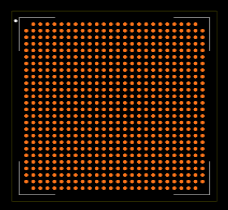EP2S30F672I4N FPGAs: Features, Applications and Datasheet
2025-01-02 10:16:43 759
EP2S30F672I4N Description
The EP2S30F672I4N is a member of the Stratix II family of FPGAs (Field-Programmable Gate Arrays) from Intel (formerly Altera). It is designed for high-performance, high-density applications, providing users with an array of configurable logic blocks, embedded memory, DSP blocks, and high-speed transceivers. It operates at lower power compared to other FPGA families, making it an ideal choice for applications requiring both performance and energy efficiency.
EP2S30F672I4N Features
Technology: Manufactured using a 90nm process technology.
Logic Elements: Contains 30,000 logic elements (LEs).
Embedded Memory: Up to 1.3Mb of embedded memory (RAM).
DSP Blocks: Contains high-performance DSP blocks for signal processing.
I/O Pins: 672 I/O pins with support for high-speed I/O standards.
Power Supply: Operates with a low-power requirement.
Clocking: Provides high-speed clocking options, including a dedicated global clock network.
Configuration Options: Supports multiple configuration modes, including JTAG and AS (Active Serial) modes.
Speed Grade: Speed grade of -4, ensuring faster performance.
Security: Offers encryption options for secure device configuration.
Package: Available in a 672-pin F672 package.
Embedded Logic: Includes embedded logic blocks that support a range of applications from signal processing to control logic.
EP2S30F672I4N Applications
Communications: Used in high-performance communication systems, including 4G/5G base stations, routers, and wireless infrastructure.
Networking: Suitable for advanced networking hardware that requires large amounts of data processing and low-latency operations.
Signal Processing: Ideal for applications that need heavy digital signal processing (DSP), such as audio/video processing or radar systems.
Automotive: Utilized in high-speed automotive applications such as ADAS (Advanced Driver Assistance Systems).
Industrial: Used in industrial automation and robotics, including motor control and vision systems.
Consumer Electronics: Found in high-performance consumer electronics devices requiring custom logic solutions.
EP2S30F672I4N CAD Model
Footprint

EP2S30F672I4N Alternatives
Xilinx Kintex-7: A high-performance FPGA offering similar capabilities for signal processing and communications.
Intel Cyclone IV: Offers lower power consumption for cost-sensitive applications, though with fewer features than Stratix II.
Lattice ECP5: Another alternative for low power and high performance but more cost-effective for simpler tasks.
Microsemi SmartFusion2: A combination of FPGA and ARM Cortex-M3 processor, suitable for embedded systems.
Intel Arria 10: For more advanced applications requiring higher logic density and transceiver performance.
EP2S30F672I4N Manufacturer
Intel Corporation is a leading global technology company, widely recognized for its innovation in semiconductor manufacturing. Founded in 1968 and headquartered in Santa Clara, California, Intel is best known for its microprocessors, which power the majority of personal computers, servers, and mobile devices. Intel’s processors, such as the Intel Core series, Xeon, and Atom chips, are at the heart of modern computing. The company also specializes in graphics processing units (GPUs), memory, storage, and networking technologies.
Intel has been a pioneer in the development of advanced technologies, including artificial intelligence (AI), autonomous driving, and 5G connectivity. Its products and innovations are instrumental in driving progress across industries such as cloud computing, data centers, and edge computing. With a focus on sustainable innovation, Intel is committed to creating technologies that power the future of computing while addressing environmental challenges. Through continuous research and development, Intel shapes the digital landscape and remains a key player in advancing the global technology ecosystem.
EP2S30F672I4N FAQs
Can the EP2S30F672I4N function without a clock input?
No, the EP2S30F672I4N requires a clock input for normal operation. While it has the capability to handle multiple clock sources, the FPGA won't function without one. However, designers can implement internal PLLs (Phase-Locked Loops) or clock dividers to generate the necessary timing.
What happens if you try to operate the EP2S30F672I4N below the specified voltage range?
Operating the EP2S30F672I4N below its specified voltage range (1.14V for core and 2.5V for I/O) can lead to unreliable performance, such as logic errors, improper configuration, or even complete failure to configure the device. It's critical to ensure that the power supply is within the specified range for stable operation.
Can I use the EP2S30F672I4N for quantum computing applications?
While the EP2S30F672I4N is highly programmable and capable of complex computations, it is not designed for quantum computing tasks. Quantum computing relies on quantum bits (qubits) and specialized quantum processors, which are fundamentally different from the digital logic-based architecture of the EP2S30F672I4N.
What happens if the EP2S30F672I4N is exposed to extreme electromagnetic interference (EMI)?
In environments with high EMI, the EP2S30F672I4N may experience transient errors, misconfigurations, or failure to process logic correctly. It is recommended to use additional shielding or filtering in such environments to ensure the FPGA operates as expected.
Can the EP2S30F672I4N be used for time travel simulations?
While the EP2S30F672I4N offers impressive computational capabilities, it is not capable of simulating time travel, as this is beyond the current capabilities of any available FPGA or computer system. Time travel remains a concept in theoretical physics and not applicable to current digital simulation technologies.




